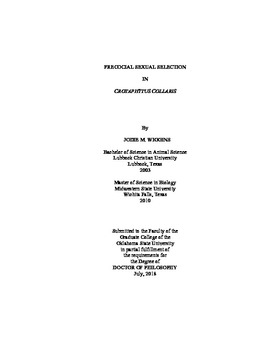| dc.contributor.advisor | Lovern, Matthew B. | |
| dc.contributor.advisor | Fox, Stanley F. | |
| dc.contributor.author | Wiggins, Jodie M. | |
| dc.date.accessioned | 2019-03-22T18:57:13Z | |
| dc.date.available | 2019-03-22T18:57:13Z | |
| dc.date.issued | 2018-07 | |
| dc.identifier.uri | https://hdl.handle.net/11244/317670 | |
| dc.description.abstract | We investigated the relationships between indicators of fitness and a sexually dichromatic color (hatchling orange bars, HOB) that appears on the side of the body in hatchling male collared lizards (Crotaphytus collaris). We found that hatchling females preferred to associate with males bearing brighter HOB and that two measures of HOB were significantly positively related to the probability that hatchling males sire offspring (HOB area) and how many offspring they sire (brightness). Additionally, offspring sired by hatchling males were disproportionately female. Having found the above evidence that HOB are a sexually selected signal, we sought to determine if there was evidence that this signal is maintained honestly. To accomplish this we investigated relationships between measures of HOB and potential indicators of male quality and evidence of costs associated with full HOB expression. HOB area was significantly positively related to hatchling males' immune function, aggression, and testosterone level, but appeared to be negatively related to survival at its highest values. We propose that these findings taken together point to a dual-signal system in C. collaris in which some males more fully develop HOB, mate early, then die, while others less fully develop HOB, survive to their yearling season when they develop the typical blues, greens, and yellows of adults and mate then. We further determined the pigment profile of HOB to assess if this signal is a candidate for hypotheses proposing maintenance of honesty via carotenoid trade-off or shared pathways. We found that HOB are overwhelmingly composed of pteridine pigments. Thus, we herein provide evidence for the existence of a pteridine-based precocial sexually selected signal in C. collaris. | |
| dc.format | application/pdf | |
| dc.language | en_US | |
| dc.rights | Copyright is held by the author who has granted the Oklahoma State University Library the non-exclusive right to share this material in its institutional repository. Contact Digital Library Services at lib-dls@okstate.edu or 405-744-9161 for the permission policy on the use, reproduction or distribution of this material. | |
| dc.title | Precocial sexual selection in Crotaphytus collaris | |
| dc.contributor.committeeMember | Van Den Bussche, Ronald A. | |
| dc.contributor.committeeMember | Grindstaff, Jennifer L. | |
| dc.contributor.committeeMember | Doust, Andrew N. | |
| osu.filename | Wiggins_okstate_0664D_15894.pdf | |
| osu.accesstype | Open Access | |
| dc.type.genre | Dissertation | |
| dc.type.material | Text | |
| thesis.degree.discipline | Integrative Biology | |
| thesis.degree.grantor | Oklahoma State University | |
